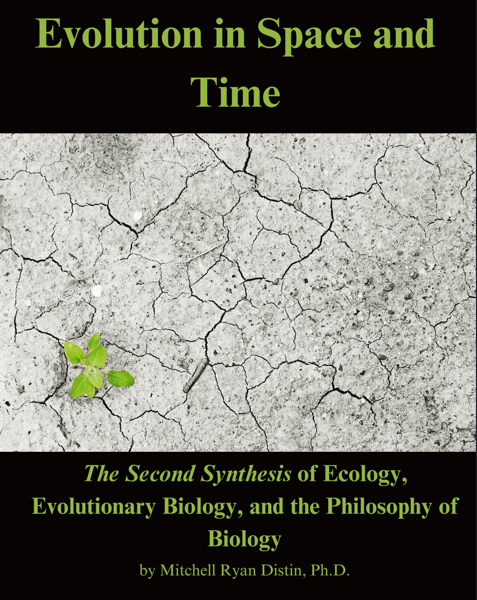Link to a downloadable PDF: Evolution in Space and Time: The Second Synthesis of Ecology, Evolutionary Biology, and the Philosophy of Biology
Book Summary
Change is the fundamental idea of evolution. Explaining the extraordinary biological change we see written in the history of genomes and fossil beds is the primary occupation of the evolutionary biologist. Yet it is a surprising fact that for the majority of evolutionary research, we have rarely studied how evolution typically unfolds in nature[1], in changing ecological environments, over space and time.
This has resulted in a biology that has yet to realize its scientific potential. Since its modern origins, an implicit yet stark division between theoretical and empirical efforts has beset biological practice. The first major synthesis of biology—i.e., the Modern Synthesis (circa 1918-1956)—united the subdisciplines of biology and organized them into a coherent theoretical and mathematical framework of evolution, leading to the legitimization of biology as a scientific discipline and natural selection as a reputable scientific theory. Yet while ecology played a major role in the eventual acceptance (and dominance) of the population genetic viewpoint of evolution in the synthetic era, it held a lesser role in the development of evolutionary theory until the 1980s, when we began to systematically study the evolutionary dynamics of natural populations in space and time. As a result, evolutionary theory was initially constructed in an abstract vacuum that is unrepresentative of evolution in nature.
Evolutionary biology has since undergone a profound shift in thinking spurred by its recent synthesis with ecology. Ecological insight has described a biological world that is immeasurably complex, with causal relations extending from the smallest macromolecule to the largest ecosphere, interweaving between symbiotic species, and dependent on many interacting causes that vary in space and time.
Unifying ecology with evolutionary biology has thus progressed our knowledge of natural selection theory. We are no longer asking if natural selection is operating in natural populations but how natural selection affects natural populations over spatiotemporal contexts. Such profound advancements have recently revealed how natural selection varies in strength, direction, form, and, more surprisingly, level of biological organization. The causal dynamics of natural selection are no longer reducible to lower levels of biological organization (i.e., individuals, selfish genes) over shorter timescales but have been expanded to include adaptation at all levels and timescales.
The novel concept of evolvability plays an organizing role throughout this book since its recent rise to popularity provides some of the best evidence of how biologists have persistently neglected evolution in space and time throughout history. Since Darwin, evolutionary biologists have routinely failed to explain the evolutionary existence of adaptive genetic variation mechanisms (e.g., adaptive mutation, sexual recombination, HGT)—what I elucidate as an active problem for evolutionary biology called the paradox of adaptive variation. Mounting evidence in the 20th century exposed an internal anomaly between the available evidence on adaptive genetic variation and natural selection theory. Not only were genetic variation mechanisms exposed to selective environments, overturning the modern synthetic assumption of random variation, but most species were found to exhibit greater flexibility (i.e., evolvability) to cause adaptive genetic changes in response to ecological pressures than was theoretically allowable. Evolvability, as an emergent adaptation of populations that is prompted by ecological changes, thus finally became revealed within an evolutionary biology that embraced evolution in space and time. How such a central process as evolvability can go relatively unnoticed in theory until recent times thus highlights the areas of biology that warrant urgent progress.
Evolutionary biology is currently suspended at an intermediate stage of scientific progress that calls for the organization and integration of overflowing knowledge stockpiles—produced by its recent synthesis with ecology—into a coherent and unified theoretical framework, just like that seen in the first synthesis. This is where recent advancements in the philosophy of biology can be of great use, acting as a bridge between previously divided subdisciplines of biology and inventing new theoretical strategies to organize and accommodate divided knowledge. Philosophers have recommended transitioning away from outdated philosophies that were originally derived from physics within the philosophical zeitgeist of logical positivism (i.e., monism, reductionism, and monocausation) and toward a distinct philosophy of biology that can capture the natural complexity of multifaceted biological systems within diverse ecosystems—one that embraces the emerging philosophies of pluralism, emergence, and multicausality.
I, therefore, see recent advances in ecology, evolutionary biology, and the philosophy of biology[2] as laying the groundwork for another major biological synthesis, what I refer to as the Second Synthesis because, in many respects, it is analogous to the aims and outcomes of the first synthesis (but is notably distinct from what some have self-proclaimed as the extended evolutionary synthesis). With the general development of a distinctive philosophy of science, biology has rightfully emerged as an autonomous science.
In this book, I offer an historical reconstruction of the philosophical, technological, and natural forces that led to the Second Synthesis in hopes of recognizing the significant advancements that have overtaken biology in the past generation. I then offer my normative recommendations, prescribing a pluralistic theory of natural selection that is capable of explaining complex emergent phenomena like evolvability to resolve the paradox of adaptive variation. I do so by building a bridge between greater biology and the history/philosophy of biology, bringing into focus the primary achievements made by historians and philosophers over the past generation and how these advancements can modernize biological thought.
The first synthesis legitimized biology; the Second Synthesis autonomized biology. Now it is once again time to organize and structure our new knowledge into a coherent theoretical framework, using the theoretical strategies suggested by philosophers to represent a new way of looking at the evolution of life on Earth.
[1] Evolution derives from the Latin ‘evolutio’, which translates to the unrolling or the unfolding (of a book or papyrus).
[2] There is a fourth prospective element of the Second Synthesis that I could not grant a central role in this book, and that is development. Evolutionary developmental biology has recently transformed our concepts of biological innovation and novelty. While these concepts are intertwined within the research on evolvability presented in this book, they live, for now, outside of the scope of this book, as I cannot reasonably argue for their inclusion until I see further evidence of how development affects evolutionary trajectories in the long-term (and, speaking with humility, gain greater knowledge in this area, since the evidence may lie outside of my causal perspective).

